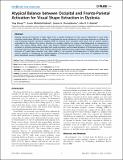Atypical Balance between Occipital and Fronto-Parietal Activation for Visual Shape Extraction in Dyslexia
Author(s)
Zhang, Ying; Gabrieli, John D. E.; Gabrieli, Susan; Christodoulou, Joanna
DownloadZhang-2013-Atypical Balance bet.pdf (1.803Mb)
PUBLISHER_POLICY
Publisher Policy
Article is made available in accordance with the publisher's policy and may be subject to US copyright law. Please refer to the publisher's site for terms of use.
Terms of use
Metadata
Show full item recordAbstract
Reading requires the extraction of letter shapes from a complex background of text, and an impairment in visual shape extraction would cause difficulty in reading. To investigate the neural mechanisms of visual shape extraction in dyslexia, we used functional magnetic resonance imaging (fMRI) to examine brain activation while adults with or without dyslexia responded to the change of an arrow’s direction in a complex, relative to a simple, visual background. In comparison to adults with typical reading ability, adults with dyslexia exhibited opposite patterns of atypical activation: decreased activation in occipital visual areas associated with visual perception, and increased activation in frontal and parietal regions associated with visual attention. These findings indicate that dyslexia involves atypical brain organization for fundamental processes of visual shape extraction even when reading is not involved. Overengagement in higher-order association cortices, required to compensate for underengagment in lower-order visual cortices, may result in competition for top-down attentional resources helpful for fluent reading.
Date issued
2013-06Department
Massachusetts Institute of Technology. Department of Brain and Cognitive Sciences; McGovern Institute for Brain Research at MITJournal
PLoS ONE
Publisher
Public Library of Science
Citation
Zhang, Ying, Susan Whitfield-Gabrieli, Joanna A. Christodoulou, and John D. E. Gabrieli. “Atypical Balance between Occipital and Fronto-Parietal Activation for Visual Shape Extraction in Dyslexia.” Edited by Markus Lappe. PLoS ONE 8, no. 6 (June 25, 2013): e67331.
Version: Final published version
ISSN
1932-6203